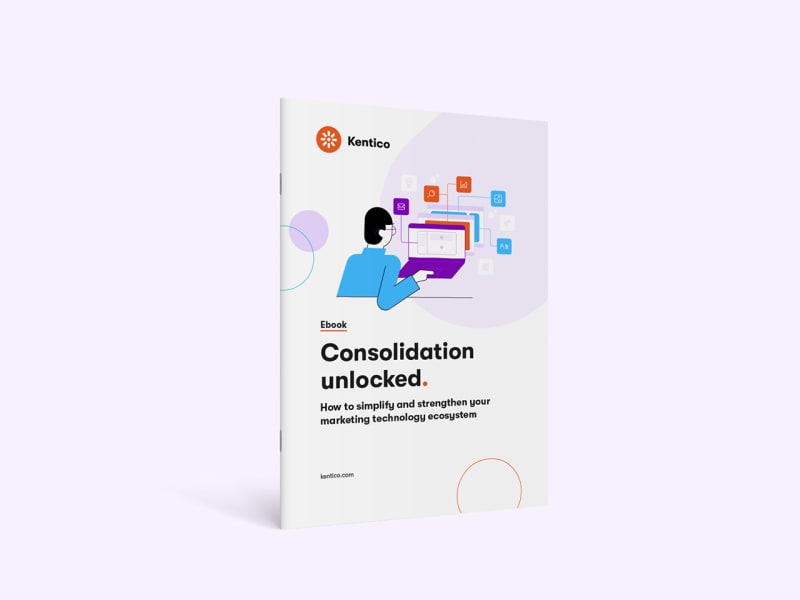Marketing teams are relying on a growing number of tools, which can create more chaos than efficiency. Join us for an experts’ discussion on how we reached this level of martech complexity and how consolidation presents a way forward.
Managing multiple tools not only drives up costs, increases security risks, and complicates compliance, but also causes marketers to frequently face fragmented data, inconsistent messaging, and complicated workflows as they switch between different systems.
In this roundtable, we asked our experts: What has driven marketing teams to adopt so many tools? We’ll also explore what is holding them back from consolidating and some best practices for when they do.
The best-of-breed illusion

"There are many reasons why modern digital marketing organizations may find themselves relying on an ecosystem of overlapping systems and tools, the most common being a desire to seek best-in-breed performance for each piece of their marketing stack. But combining different tools inevitably leads to siloed data, asynchronous licensing, extra training, and constant work to maintain integration points—all issues that an all-in-one DXP solves for.”
Many marketers take a best-of-breed approach because it allows them to choose specialized solutions that excel in specific areas and offers flexibility, customization, and the ability to adapt quickly to evolving marketing needs.

"They have an IT problem and search for a solution for this—and only this—problem and do not see the whole picture. They go to consultants with this one thing and the consultants also don't see the whole picture.”
A one-at-a-time or best-of-breed approach can lead to an overwhelming tech stack as the number of specialized tools grows over time. Each tool comes with its own data set, user interface, and integration requirements, making it challenging to create a seamless workflow. The lack of cohesion can reduce operational efficiency and make it harder for marketers to measure the overall performance of their campaigns.
Lack of strategic approach
Without a strategic framework, there is often insufficient planning for how acquired tools will integrate into existing workflows or contribute to overall marketing objectives.

"Many marketing teams in rapidly growing companies lack a strategic approach to managing the future growth of their websites or content management systems (CMS). Their primary CMS often doesn’t support microsites or multisites, and acquiring additional licenses is too costly. As a result, they resort to quick, budget-friendly solutions to launch campaign microsites.”
This can lead to redundant functionalities, inefficiencies, and increased operational costs. The complexity is further compounded by difficulties in maintaining consistent data quality, ensuring security across multiple platforms, and achieving a seamless customer experience.

“Additionally, various divisions within one company are responsible for different things: content (marketing team), newsletters (another marketing team), job offers (HR), products (sales team), etc. Each division chooses their favorite tool.”
This lack of coordination leads to multiple overlapping or redundant tools being introduced, and the lack of a cohesive strategy means that the full potential of each tool is not realized, and the overall effectiveness of the marketing stack is diminished.

"What can be done about it? We could solve the lack of clarity related to N different CMS systems by introducing CMS system N+1 (can be applied repeatedly)? Or we could build a wall and hide the chaos behind it (giving the wall a futuristic name, like "AI assistant"? Or we could go with the answer no one wants to hear: discipline.”
The need for speed

“Marketing teams need to be agile, fast, and super-efficient to handle all the tasks and deliverables that come their way. Too often, large CMS/DXP project implementations are botched by inexperienced vendors or teams and result in solutions that are simply too slow, hard to update, and difficult to adapt to changes.”
Poorly executed systems result in rigid workflows and complicated processes, where even minor updates require significant time and resources. This loss of flexibility impedes the ability to deliver timely, effective campaigns. Frustrated by these limitations, marketers often look for alternatives to ensure they can meet deadlines and respond to market demands.

“Even though a CMS may have a landing page template/layout built in, often marketers have a need to create a unique landing page and to work outside pre-built modules and templates in order to implement fast. The reason the CMS is often not able to be modified quickly enough to support a marketer's urgent needs is because it often requires coding skills. However, this sprawl of tools then creates a maintenance nightmare."
While the workaround approach may sometimes be necessary for short-term needs, it can undermine long-term strategic goals, as marketers are forced to prioritize speed over optimization and innovation.
IT-marketer tensions

"Marketing teams have always used their own tools because they are afraid of being hindered in their day-to-day operations by having to wait for consent or global solutions from their IT-departments."
Marketing teams are often held back by IT due to conflicting priorities, long implementation timelines, and complex systems. IT is typically focused on security, stability, and scalability, not marketing’s need for rapid adjustments, new integrations, or tool deployments. Delays and bottlenecks make it harder to capitalize on trends and respond to customer behavior in real time.
It’s what Mike Wills from BlueModus refers to as “IT Prison."

“The missions of marketing teams and IT teams are BlueModus often in tension, and in larger organizations the tension can be strong. Marketing teams need to act fast to stay ahead and try new ways of reaching their audiences. IT teams are entrusted with keeping systems secure and stable. This causes marketing teams to prefer no-code solutions that they can implement on their own.”
This approach, while empowering in the short term, can lead to the proliferation of shadow IT, where marketing manages technology independently, potentially creating security vulnerabilities, data silos, and integration challenges across the broader organization.
So, why aren’t organizations consolidating?

"The issues are varied: Firstly, they are embedded with their existing tool. Secondly, the cost and effort of migration is (or is perceived to be ) too high, as is the cost of entry (plus ongoing costs) for a consolidated DXP. Plus there is a perceived risk of having "all eggs in one basket."
Many organizations view consolidation as expensive and disruptive, requiring data migration, retraining, and potential downtime. There's also a concern that relying on a single platform could increase vulnerability if the system fails or lacks flexibility.

“Merging various platforms into a single product would streamline operations, reduce complexity, and enhance efficiency. However, this process presents challenges such as intricate integration, technical expertise requirements, and the potential for data loss or disruption to ongoing campaigns. Finding a unified solution for a marketing team's needs can take time and may require compromises on specialised functionalities."
As a result, businesses stick with fragmented systems, believing diversification reduces risk.

“Larger companies may have been living with their complex system for so long that they are now facing the possibility of decline—their ability to innovate and adapt is hindered while operational costs and inefficiencies are growing. [...] Profitability takes a hit. However, while they’ll likely acknowledge a problem, it’s not yet hurting enough to warrant a concerted effort to fix.”
Why should organizations consolidate?
Although we didn’t specifically ask about the reasons organizations should consolidate their martech stack, many of our experts felt compelled to highlight them:

“The impact of consolidation is positive and significant. Those additional products are liabilities for IT and cyber security and if they aren't kept up to date, teams now have multiple slow, legacy systems. Marketing teams risk losing control of their brand, message, and customer experience— spread across multiple products—and often cannot achieve a holistic view of their customer data and content investments. Consolidating into a single DXP is the clear solution to these challenges.”
Consolidation simplifies management, enhances data consistency, and improves operational efficiency, allowing teams to deliver a more cohesive and personalized customer experience.

“Consolidating CMSs or DXPs improves content governance, allowing content to be managed centrally and reused across sites. It also enables unified customer analytics, simplifies system maintenance, and reduces security risks through centralized updates and single sign-in.”

“When done correctly, consolidating into one CMS/DXP should enable marketers to move faster, be more flexible, and deliver more.”
Additionally, it reduces the overhead associated with maintaining multiple platforms and mitigates integration challenges, ultimately leading to cost savings and greater agility in responding to market demands.
Our experts’ best practices for consolidation
Keen advocates of consolidation, our experts also shared their advice for those considering this approach.

"If you want to consolidate, you need to invite Marketing as a stakeholder and help them to really specify what they need and accommodate that need.”

"Marketing teams need technical partners who empathize with their mission; to act fast and help their organizations thrive.”

“Consolidation requires a full inventory of an organization's martech and experience in merging solutions into fewer products. This can be a large task for a marketing team that's already fully booked. It's important to find a digital agency partner that has experience in consolidation using a platform like Xperience by Kentico, that truly solves it with product design and migration support."

“The largest challenge facing an organization looking to consolidate to a unified DXP is project sequencing and timing: how can you replace multiple production systems without disrupting your customers and internal processes? This is why I would recommend choosing a DXP that emphasizes an open ecosystem and extensibility while also offering its own broad toolbox of advanced features. This allows for an iterative rollout wherein the new DXP can be implemented and other tools deprecated via a phased approach rather than an "all or nothing" cutover.”
Consolidation: The way forward
It's clear from our expert roundtable that the adoption of numerous tools by marketing teams often stems from a desire for specialized solutions, a lack of strategic planning, and the need for agility in a fast-paced digital landscape.
While the challenges of managing a fragmented tech stack are significant, including increased costs and operational inefficiencies, consolidation presents a promising path forward.
By integrating tools into a unified platform, such as Xperience by Kentico, organizations can streamline their operations, improve data consistency, and enhance their overall marketing effectiveness. Consolidation can lead to greater efficiency, reduced risk, and a more cohesive strategy, empowering marketing teams to deliver more impactful results.
Learn more about how consolidation can optimize your marketing strategy and enhance your ROI in our ebook, Consolidation Unlocked.
Subscribe to the Kentico Xperience newsletter
You'll receive our newsletter once a month with all the updates you need to know to keep you in the loop with the Kentico Xperience community. Just the hits—guaranteed.


